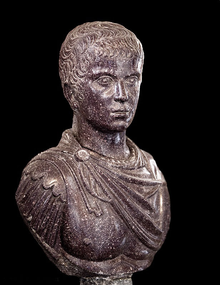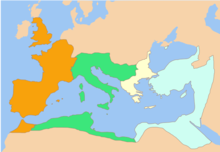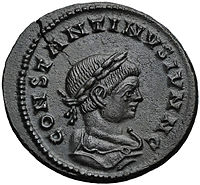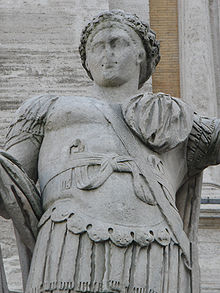- Constantine II (emperor)
-
Constantine II Emperor of the Roman Empire 
Porphyry statue of Constantine IIReign 1 March 317 – 337 (as Caesar in the west under his father);
337 – 340 (joint emperor with Constantius II and Constans, over Gaul, Hispania, and Britannia, in 340 in failed competition with Constans);Full name Flavius Claudius Constantinus Born February, 316 Birthplace Arelate, Viennensis Died 340 (aged 24) Place of death Aquileia, Italia Predecessor Constantine I Successor Constantius II and Constans Dynasty Constantinian Father Constantine the Great Constantine II (Latin: Flavius Claudius Constantinus Augustus)[1] (316 – 340), was Roman Emperor from 337 to 340. Co-emperor alongside his brothers, his short reign saw the beginnings of conflict emerge between the sons of Constantine the Great, and his attempt to exert his perceived rights of primogeniture ended up causing his death in a failed invasion of Italy in 340.
Contents
Career
The eldest, possibly illegitimate,[1][2] son of Constantine the Great, he was born at Arles in February, 316,[3] and raised as a Christian. On March 1 317, Constantine was made Caesar,[4] and at the age of seven in 323, took part in his father's campaign against the Sarmatians.[5] At the age of ten he became commander of Gaul, after the death of his half-brother Crispus. An inscription dating to 330 records the title of Alamannicus, so it is probable that his generals won a victory over the Alamanni.[5] His military career continued when Constantine I chose his son field commander during the 332 campaign against the Goths.[6]
Following the death of his father in 337, Constantine II initially became emperor jointly with his brothers Constantius II and Constans,[7] with the Empire divided between them and their cousins, the Caesars Dalmatius and Hannibalianus.[8] This arrangement barely survived Constantine I’s death, with the sons of Constantine arranging the slaughter of most of the family of Constantine I at the hands of the army.[9] As a result, the three brothers gathered together in Pannonia[5] and there on September 9, 337,[1][9] divided the Roman world between themselves. Constantine, proclaimed Augustus by the troops[1] received Gaul, Britannia and Hispania.[6]
 Division of the Roman Empire among the Caesars appointed by Constantine I: from left to right, the territories of Constantine II, Constans I, Dalmatius and Constantius II. After the death of Constantine I (May 337), this was the formal division of the Empire, until Dalmatius was killed and his territory divided between Constans and Constantius.
Division of the Roman Empire among the Caesars appointed by Constantine I: from left to right, the territories of Constantine II, Constans I, Dalmatius and Constantius II. After the death of Constantine I (May 337), this was the formal division of the Empire, until Dalmatius was killed and his territory divided between Constans and Constantius.
He was soon involved in the struggle between the different Christian streams that was rupturing the unity of the Christian Church.[5] The Western portion of the Empire, under the influence of the Popes in Rome leaned towards Catholicism and against Arianism, and through their intercession they convinced Constantine to free Athanasius, allowing him to return to Alexandria.[10] This action aggravated Constantius II, who was a committed supporter of Arianism.[6]
At first, he was the guardian of his younger brother Constans, whose portion was Italia, Africa and Illyricum. Constantine soon complained that he had not received the amount of territory that was his due, stemming from his position as the eldest of Constantine’s sons.[9] Annoyed that Constans had received Thrace and Macedonia after the death of Dalmatius, Constantine demanded that Constans hand over the African provinces, which, in order to maintain a fragile peace, he agreed to do.[9][11] Soon however, they began quarrelling over which parts of the African provinces belonged to Carthage, and thus Constantine, and that which belonged to Italy, and therefore Constans.[12]
Additional complications also arose when Constans came of age, and Constantine, who had grown used to dominating his younger brother, would not relinquish the guardianship. Therefore in 340 he marched into Italy at the head of his troops.[11] Constans, at that time in Dacia, detached and sent a select and disciplined body of his Illyrian troops, stating that he would follow them in person with the remainder of his forces.[9] Constantine was engaged in military operations around Aquileia[7] and he was killed in an ambush in Cervignano del Friuli.[11] Constans took control of his deceased brother's realm.
See also
- Itineraries of the Roman emperors, 337–361
Sources
Primary sources
- Zosimus, Historia Nova, Book 2 Historia Nova
- Aurelius Victor, Epitome de Caesaribus
- Eutropius, Breviarium ab urbe condita
Secondary sources
- DiMaio, Michael, and Robert Frakes, "Constantine II (337–340 A.D.)", D.I.R.
- Jones, AH.M., Martindale, J.R. The Prosopography of the Later Roman Empire, Vol. I: AD260-395, Cambridge University Press, 1971
- Canduci, Alexander (2010), Triumph & Tragedy: The Rise and Fall of Rome's Immortal Emperors, Pier 9, ISBN 978-1741965988
- Gibbon. Edward Decline & Fall of the Roman Empire (1888)
References
- ^ a b c d Jones, pg. 223
- ^ Zosimus 2:20:2
- ^ Victor, 41:4
- ^ Victor, 41:6
- ^ a b c d DiMaio, Constantine II (337–340 A.D.)
- ^ a b c Canduci, pg. 129
- ^ a b Eutropius, 10:9
- ^ Victor, 41:20
- ^ a b c d e Gibbon, Ch. 18
- ^ A. H. M. Jones, "The Later Roman Empire" (Baltimore, 1986), pg. 114
- ^ a b c Victor, 41:21
- ^ Zosimus, 2:41-42
External links
 Media related to Constantine II (emperor) at Wikimedia CommonsConstantine II (emperor)Born: 316 Died: 340
Media related to Constantine II (emperor) at Wikimedia CommonsConstantine II (emperor)Born: 316 Died: 340Regnal titles Preceded by
Constantine IRoman Emperor
337–340
Served alongside: Constantius II and ConstansSucceeded by
Constantius II and ConstansPolitical offices Preceded by
Constantine I,
Licinius IIConsul of the Roman Empire
320–321
with Constantine I ,
Crispus,
Licinius,
Licinius IISucceeded by
Petronius Probianus,
Amnius Anicius JulianusPreceded by
Acilius Severus,
Vettius RufinusConsul of the Roman Empire
324
with CrispusSucceeded by
Sextus Anicius Faustus Paulinus,
Valerius ProculusPreceded by
Ianuarinus,
Vettius IustusConsul of the Roman Empire
329
with Constantine ISucceeded by
Gallicanus,
Aurelius Valerius Tullianus SymmachusCategories:- 316 births
- 340 deaths
- 4th-century Roman emperors
- Imperial Roman consuls
- Constantinian dynasty
- Roman emperors killed in battle
- Constantine the Great
Wikimedia Foundation. 2010.


